|
FAQs about Naso lituratus Disease-Health
2
FAQs on Lipstick Tang Disease:
Lipstick Tang Disease 1,
Lipstick Tang Disease
3, Lipstick Tang Disease
4, Lipstick Tang Disease ,
FAQs on Lipstick Tang Disease by Category:
Diagnosis, Environmental,
Nutritional, Social,
Trauma, Pathogenic
(plus see
Tangs/Rabbitfishes &
Crypt), Genetic,
Treatments
Related Articles: Lipstick Tangs, Naso
Tangs, Surgeonfishes/Tangs/Doctorfishes and Marine
Aquariums,
Related FAQs: Lipstick Tangs 1, Lipstick Tangs 2, & Lipstick Tang Identification, Lipstick Tang Behavior, Lipstick Tang Compatibility, Lipstick Tang Selection, Lipstick Tang Systems, Lipstick Tang Feeding, Lipstick Tang Reproduction, & Naso Tangs 1, Naso Tangs 2, Naso
Tangs 3, Naso ID, Naso Behavior, Naso Compatibility, Naso Selection, Naso Systems, Naso Feeding, Naso Disease, Naso Reproduction, Surgeons In General, Tang
ID, Selection,
Tang
Behavior, Compatibility, Systems, Feeding, Disease,
|
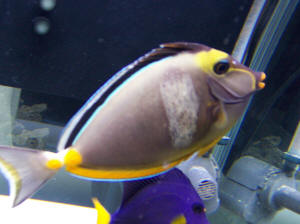
|
Surgeonfishes: Tangs for Marine Aquariums
Diversity, Selection & Care
New eBook on Amazon: Available here
New Print Book on Create Space: Available
here
by Robert (Bob) Fenner |
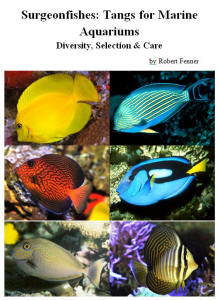 |
|
Re: High nitrate's effects on Nasos skin? Naso
Tang/Health 3/28/09
Greetings Salty Dog.
<Hello Dee>
I have re-read your instructions regarding that skimmer tube, and
saw my mistake in reading them. My sincerest apologies.
<No problem.>
I returned it to its upright position, pushed it back down
1/2" as you told me, and will watch for color of skimmate
for the next 2 days. Attached are 4 images of my set up. My Nasos
blotchy skin, full tank view, close up of skimmer, and close up
of sump. I live in Victorville, California. I am on my way out to
get the Salifert test kits, I have seen them. I agree with you
200%. I should have asked more, learned more upfront. I had been
talking with this local LFS for 2 yrs. prior to set up. He
assured me he would install the best needed for my system, and
teach me along the way. He installed all of this, stiffed me on
everything except the water. We discussed my lack of knowledge, I
begged him not to just install it and leave, he said he
wouldn't. But once he got paid, he began failing to show up
for meetings/maintenance/water changes/questions, voicemail stays
on, haven't heard from him since. Found a different shop,
that person has been maintaining this tank for a year. I called
my self learning while he was doing it, obviously not nearly
enough. My fault. I took over water changes just 5 months ago.
Reading Bob's book, the FAQ's here, visiting lots of
shops within 100 mile radius, asking, absorbing as fast and much
as possible. I am tap dancing as fast as I can, I promise. With
all of my outings, I have since learned he does this to everyone.
Literally at least a half a dozen people in different areas has
told me the same. He has one pay upfront, he brings out the
smallest equipment, pockets the rest.
Now I know. You are totally right. Thank you for your help. I
purchased some Poly Filter after I responded to you. I indeed
remembered what a mechanical filter was, please forgive my
panicked responses. I am making more work for you. I understand
your explanation, my skimmer is too small for this tank. Thanks
so much. I got it.
I have 6 Yellow Tail Damsels, 1 Raccoon Butterfly, 1 Pearlscale
Butterfly, 1 Naso Tang, 1 Majestic Angel, 1 Coral Beauty, 1
Bi-Color Dwarf Angel, 1 Banggai Cardinal, crabs, snails, 3
urchins.
That's it. My sump dimensions where the skimmer is:
14" deep (from back wall to front), 12" wide (side to
side), 35" tall, headroom.
My Butterflies and Naso are the ones skipping around the tank,
twitching of sorts. Would a larger skimmer add more dissolved
oxygen to the tank, helping this behavior?
<As far as the oxygen goes, yes, you would be processing more
gallons per hour. As for the twitching, not a good sign, is
possible the mentioned fish may have a parasitical disease and
would be a good idea for your local man to come have a look and
soon. Do any of the "twitching" fish have very small
white spots on them? Would be comparable to grains of salt. Do
read/learn here about this.
http://www.wetwebmedia.com/ichart2mar.htm
Another question I have is what type of diet are these fish on,
what are you feeding them? A healthy diet can go a long way
in disease prevention. As for the nitrate level, your tank
photo isn't indicative of a tank with the high nitrate levels
that you report from the 5 in 1 strip results. I'll be
very interested in your Salifert nitrate reading. On to the
skimmer. Since you are already familiar with the ASM's
operation, I suggest you get the ASM G4, will not be another
learning curve thrown at you. May want to order this item from
Marine Depot, located in Garden Grove, California, not very far
from you and Bob Fenner for that matter. Look here.
http://www.marinedepot.com/ps_ViewItem~category~ASM_G_4_Protein_Skimmer_w__S
edra_5000_Pump_Saltwater_Aquarium_Supplies_Protein_Skimmers_In_Sump_Skimmers
_Venturi_Over_250_Gallons~vendor~All_Seas_Marine_(ASM)~SearchStr~~action~vie
w~idProduct~AG1191~idCategory~FIPSISVSOT.html
As to your present skimmer, and looking at the photo, you have a
good accumulation of skimmate slime on the top neck of the main
body. Any slime like this needs to be removed on a minimum weekly
basis along with cleaning the collection cup/riser tube of same.
Allowing this to build up greatly reduces the skimmer's
efficiency.>
Peace be to you, again my apologies for all.
<Not a problem. James (Salty Dog)>
Dee.
|
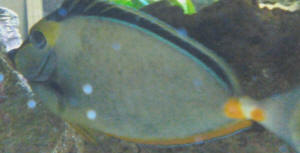 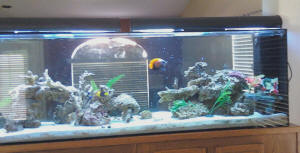
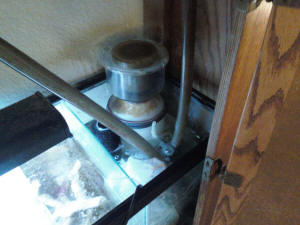 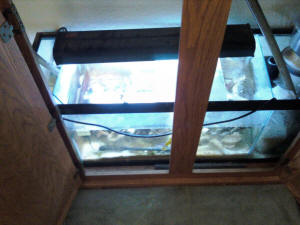 |
|
Re: High nitrate's effects on Nasos
skin? Naso Tang/Health 3/28/09
G'Day to you, thank you for your input/help.
<You're welcome.>
I purchased the ASM G3 yesterday, and installed it. Thanks for
doing some homework on where to purchase. The better sized G4 for
my system, will not fit in my sump.
<With a moderate fish load, the G3 should be fine.>
No, none of the twitching fish have any white spots on them. No
Ich signs. I lost a damsel and my Pearlscale Butterfly last
night. Before succumbing, he had a fixed gaze in his eyes. His
color had turned to brown in some areas, mainly his face.
<The Pearlscale Butterflyfish are hardy as far as
Butterflyfish go, but still not an easy fish to keep. My
Naso and Majestic have the same look in their eyes, but Majestic
is swimming/eating/looking fine, Naso is still blotchy and
twitching. Could this be Chloramine poisoning from the
tap?
<Depends on the level of the Chloramine. Butterflyfish demand
pristine water quality and if your nitrates were indeed 200ppm+,
then this will have a negative effect on the fish.>
I have adjusted the 4 power heads in each top corner downward and
outward a bit for more oxygen in the water, they were 90%
upwards, producing more surface aeration. Now it is about 20%
surface aeration.
<Doing what you did just decreased the oxygen saturation, the
surface needs to be agitated to allow gas/air exchange.>
I am testing with my Salifert N03 kit today, will shoot you the
results later.
<Good.>
The only shop around here who carries it won't get it in
until this afternoon, so I'll be driving 50 miles to get this
test kit. I wanted to write you back ASAP to try and prevent more
fish losses. Chlorine? If I add in some NovAqua to
eliminate chlorine/ammonia, won't that make the skimmer go
overboard?
<Yes, will likely have to be shut off.>
What can I safely add to eliminate the chloramines then?
<Aerating your top off water for 24 hours will eliminate the
Chloramine. Many folks just keep a Rubbermaid tub with
aerated fresh water for top offs. Another route to go is by using
an RO water purification system.>
Ammonia readings are zero, nitrite is at zero also. What, the do
you think is poisoning them?
<Don't know, but water quality should be your first goal
now. Could be that the Butterflyfish was caught by cyanide and
this eventually kills the fish. Hard to believe you lost a
damsel, they are almost bullet proof. Have you had him
long?>
The 5 in 1 test strip still reads the nitrate at 50, that is a
stressor. So it is either the Chloramine or the nitrate killing
them?
<How did you arrive at having Chloramine present in your
water, did you test?>
So many of these products are discussed here in other sections, I
have seen/read dozens. Which of them do you prefer to
eliminate the chloramines?
<Aeration, doesn't make sense to add a product and then
have no protein skimming.>
I feed them New Life Spectrum pellets, soft Spirulina pellets,
Nori sheets soaked in Selcon & Boyd's Vita Chem
alternately, frozen P.E. Mysis, Marine Cuisine, krill, squid, H2O
Life Formula 1, all also soaked in the above mentioned vitamins.
I mix up the choices 2x a day.
<Sounds good. Were all fish eating the New Life Pellets? It is
a very nutritious food, use it myself.>
Now you really have my attention with your observance of my tank
photo. I am actually encouraged by your feedback. What does a
high nitrate laden tank look like compared to mine? How can you
tell just by looking at my tank photo?
<What I expected to see was some Cyanobacteria growth and
nuisance algae. Your tank looks reasonably clean of
such.>
I see the goop in the neck of my old G1 skimmer now that you
point that out, I'll be sure and keep the new one clean,
along with the riser tube.
<Yes, a cleaning of at least once weekly.>
Excellent support here, I'll send results soon
Thanks so much.
<You're welcome. James (Salty Dog)>
Re: High nitrate's effects on Nasos
skin? Naso Tang/Health 3/30/09
Hello James, (Salty Dog),
<Hello Dee, sorry for the delay, been busy this
weekend.>
I have performed the Salifert test for N03, it is reading the
bright magenta color at 100.
<Ouch.>
Thank you for this specific test recommendation, I will continue
using all of their test kits for each element. I moved all 4 of
the power heads back up towards the surface, as you suggested. I
hooked the small skimmer back up to help
move out the build up until this new one begins skimming green
stuff.
<You're thinking.>
I cleaned out the old one really good before using. I am now
running both skimmers in sump. I now have 3 spots of Cyano on the
rocks, and 4 small patches of bright green algae on the glass
now.
<During the next water change, siphon the Cyano off, do not
brush off, will just be spreading it.>
More skimming, continued water changes, better water circulation,
those algaes should clear up soon?
<Should.>
I will be purchasing a 60 gallon RO unit Tuesday for my water
changes. I've actually had my Pearlscale Butterfly and
damsels for 2 years now, always perfect health, they were my
first fish. So no possibility of cyanide for him in this
case.
<Nope.>
My damsel did not die after all. He is blotchy like the rest of
them, fins fraying, he was just lying on the sand in shock, he
is
up and around now. I'm doing a 10% water change in
moments. No, I did not test for chloramines, I was
assuming, since my nitrites and ammonia are at zero, besides the
nitrate, I figured that would be the only other toxic
present.
<Likely.>
But now I see that it is not the high concentration of nitrate
that is weakening them, it is the stress of living in the toxic
levels of nitrate.
<Yes, is not good.>
You convinced me, no chemicals. Good, days-long aeration is best,
thanks so much. The Majestic, Coral Beauty, Bi-Color,
Pearlscale and Raccoon all love NLS pellets, but my Naso may pick
them up every now and then. She is a Nori and P.E. Mysis fan
instead.
<OK.>
Thank you for your patience. What say you to 2 skimmers running
to skim as much as possible until the bigger one takes off and
another water change?
<Yes, run both skimmers and I'd do 10% changes every week
until the nitrate level gets down around 20ppm>
The Raccoon is darting all over, but the Majestic, Naso, 2
pygmies are swimming fine, just blotchy skin.
<Question for you...When doing water changes do you use a
gravel cleaner type siphon? If not, do get one. It will allow you
to churn the substrate and suck out plenty of nastys. If this has
never been done, you likely have a small hydrogen sulphide
factory in the substrate, another negative for your fish. You
won't believe the color of the water in your dump bucket when
you're doing this. Obviously you won't be able to vacuum
the entire substrate in one water change so it is best to start
at one end then identify where you stopped. On the next water
change, continue and move on. It is also a good idea to do this
with every future water change with your type of system.>
Waiting for your feedback, and thankful for your time.
<Welcome. James (Salty Dog)>
Dee.
Re: High nitrate's effects on Nasos
skin? Naso Tang/Health/Now Treating Cloudy Eyes
3/30/09
Hello James, thanks dearly for your attention.
<Welcome.><<And Dee, James has asked me to chime in
as well. BobF>>
Yes, I do use a siphon at the end of my hose for water changes,
and always do a 2 ft. long area of top sand siphoning. Salty Dog,
I have been reading the FAQ's on cloudy eye all morning. My
Naso now has it, the Raccoon Butterfly still does, as well. My 10
gal QT will not hold my Naso, nor can I catch the Raccoon for QT
without stressing him and the others out even more.
<<It may well be best to try and discern the net/root cause
of the problem in the main tank... and leave your fishes
there>>
And the Bi-Color pygmy looks to be in the beginning stages of
it. Just this time, can I medicate the tank with Maracyn 2?
Removing all carbon/Chemi-Pure?
<<RMF would not use an antibiotic here. The real problem is
little doubt environmental... I would add some pads of PolyFilter
to your carbon use>>
The original skimmer is doing a great job of skimming lots of
dark green like it used to. The new one is still filled
with just clear water. I have read Bob's instructions on how
to make a big QT using a Rubbermaid, aeration and a heater, but
even if I were to catch the Raccoon, Bi-Color and Naso to treat
for cloudy eye, my Banggai, Majestic Angel and Coral Beauty may
come down with the same, so under these circumstances, do you
recommend I treat the entire tank for cloudy eye?
<I'll hook up with Bob since disease treatment is not my
forte. I will see what he recommends for treating a large
tank.>
All of this Chemi-Pure, water changes (used store bought drinking
water for the last one, no time to let tap sit), is not helping
these nitrates get past this reading. I won't bother you with
this much longer, I just need your input on these 2 things, the
cloudy eye treatment, and reducing nitrates faster.
<I went through the nitrate problem with you already. Outside
of what you are doing, there isn't a way to speed it up
outside of costly massive (50%) water changes which you likely do
not have the facilities to do anyway. Remember, it
didn't happen overnight and it's not going to go away
overnight.>
You have been a real coach, thank you.
<You're welcome. James (Salty Dog)>
Dee.
<<Dee, you must need address the water quality... including
the massive water change possibility James alludes to.
RMF>>
Re: High nitrate's effects on Nasos
skin? Naso Tang/Health/And Now Cloudy Eye Treatment
3/30/09
Greetings James (Salty Dog).
<Hello Dee.>
I have an idea I want to run by you. What do you think about me
doing a 150 gallon water change? These 30 gallon ones don't
seem to be working.
<I brought this up in a previous email but didn't know
whether you had the facilities to accomplish this. To be
effective, the entire 150 gallons would need to be changed in one
session.>
Changing out half seems drastic and refreshing for them. This is
all I can think of now to do to get these nitrates and stress
down quickly. Will that be too diluted? Take out too much
at once?
<You must be sure the pH, temperature, and salinity are the
same as the display tank. I don't understand what you mean by
"diluted".>
Even if it stressful, I think they'd get over that easier
than living in these high nitrates.
<Will not be stressful if done correctly as above.>
One of the damsels is getting a large red infection on his
forehead. The environment is really bad. I plugged up a larger
pump for one of the return hoses 2 weeks ago. When I did, tons of
uneaten food/poo shot right back into the tank from 3-4 weeks of
an non operating return pump.
<Seems like you are always encountering additional problems.
In a tank your size, you should be looking at a total flow rate
of at least 3000gph, this will keep waste stirred up and find
it's way to the mechanical filter. What is your total
flow rate including return pump and powerheads?>
Anthony at WetWeb told someone that nothing good happens fast in
an aquarium. I agree in this case.
<In full agreement with Antoine.>
I just can't fix this fast enough. It took 3 hours for all of
it to clear up. The damage was done by then. That, plus my
constant overfeeding is when all of this nitrate/toxin issue
began. So, half a water change, 150 gallons, what do you think to
help lower these nitrates now?
<If you have the facilities to do this, yes, most definitely.
Where did all the uneaten food/poo end up that was stirred up,
removed from the tank I hope.>
My Salifert test for N03 today is still reading at 100. Am at a
loss on the next action here. Thank you dearly for your time and
attention.
<You're welcome. James (Salty Dog)>
Dee.
Re: Naso Tang/Health/And Now Cloudy Eye Treatment
3/31/09
Hello again, this will indeed be my last message.
<OK>
I have learned much from you. Thank you for your compassion and
patience.
<You're welcome.>
Yes, I am encountering new problems, these issues have a domino
effect. Once that one over there hit, it affected that one next
to it, and so on. Yes, you are correct again, you absolutely did
suggest a half water change, my apologies again. I will buy
another 30 gallon can, and do it all at once, in one session.
What I meant by diluted was the level of nitrates in the water,
not the salinity or anything like that.
<Yes, you will be lowering nitrates by way of dilution, but
also keep in mind you have to address the source of excess
nutrients/waste. This may help you here. http://www.wetwebmedia.com/nutrientcontrol.htm
>
But thanks for clarifying.. All of that uneaten food/poo went
down the overflow, stayed right in the system. I thought the
skimmer would get most of it, didn't know any better, nor
think anything about it until now.
<Yes, waste needs to be out of the system, not out of
sight.>
Thank you much for the nematodes response. Bob said all there was
to say on it, certainly. I currently have 2300 gph of flow rate
in the tank, will upgrade to more powerful pumps first thing in
the morning to reach at least 3000 gph, excellent suggestion,
you're a real gem.
Thanks for helping me build my wings on the way down.
<You're welcome. James (Salty Dog)>
Dee.
|
Naso Tang: System\Health\Shipping Stress.
3/14/2009
<Hi Paul>
I have a 125 (6' long) all fish.
I have some live rock (1) blue tang, (1) clown, (1) damsel, (1)
mandarin,((1) yellow tang, (3) emerald crabs, (3) cleaner shrimp,
several snails, (2) sally crabs, and several hermit crabs.
<Pretty closed to maxed out as far as stocking is concerned>
All the water parameters are exactly where they should be.
<Actual readings would be helpful.>
The tank has been set up for 6 months and have not had one problem with
it.
I started out with a 30 a couple of years ago and learned from
there.
<OK>
Three weeks ago I purchased a (Naso) Tang (west indies?) from
Saltwaterfish.com.
<What kind? I am going to assume Naso lituratus Totally
inappropriate for a tank this size and with this level of
stocking.>
When it got here it was very lethargic and couldn't seem to get off
of its side. It carried on approximately two days this way and then
started swimming upright.
<How big was the fish - Fish under four inches rarely adapt to
captivity.
Also, it is imperative to get them eating immediately.>
During this time it didn't eat and I let it go for three more days
and it went back over on its side and never recovered. I subsequently
got my credit for the fish and decided to use it to order a larger
Hawaiian Naso Tang. (after the acclimation period)
<Any Quarantine?>
I put it in the tank and it just laid on its side. After several hours
it righted itself and seemed to be swimming OK.
<Shipping\environmental stress, starvation.>
It has yet to eat and this morning it is listing to one side like the
other one did. I have tried everything I can think of,
"entice", krill, algae, flake food, etc. but it will not eat.
The other fish in the tank are loving the different variety of things I
have offered.
<You may want to try some live Brine Shrimp>
Am I missing something? I hate to lose the guy he is very pretty but am
at my wits end. I contacted a local fish store about some help but he
was as clueless as me on what to do.
<There is much to learn here. Firstly, Nasos get BIG, needing
hundreds of gallons. Being in conditions too small will stress them to
death.>
If you can give me some advice I would be most appreciative.
<Please read here: http://www.wetwebmedia.com/naso.htm and here:
http://www.wetwebmedia.com/naso_lituratus.htm >
Thanks,
<My Pleasure>
Paul
<Mike>
Naso Tang: Acclimation\Quarantine\Health\Need More
Information 3/20/2009
Hi all!
<Well hello there!>
I have Naso Tang that has been in quarantine for 8 weeks (he had a bout
of Amyloodinium {microscopic verification}).
<Kudos to you for quarantining/verifying a disease before
treatment!>
After battling that I introduced him to my display. My quarantine tanks
are usually pH~7.8 (tap water almost always consistent. Just easier and
if I run into emergencies like I said almost always pH 7.8). When
I'm ready to transfer fish to display I increase the pH in
quarantine to 8.2 over 10 days.
<OK so far.>
Except, with this Naso. I just put him in the DT completely forgetting
to slowly increase the pH of quarantine (only realizing after his
release).
Tried to catch it but forget it in 200g full of LR.
<Hehehe, I know what you mean.>
A week later Naso was lethargic, not eating introduced foods but still
scavenged LR algae. Couple days after was very lethargic (I figure all
a result of no acclimation). The same night after noticing his
inactivity I
saw a tiny hermit clinging to his pectoral fin and dining (my Naso is 7
inches). The Naso was trying to dump the hermit but couldn't. I
grabbed a long stick hitting the crab while the Naso was trying to swim
away (either from me or the crab).
<I'm thinking the long stick...>
Finally the hermit dropped. The hermit had a good dinner. So now the
Naso has exposed white tissue, and I've since removed the
hermit.
<Ouch!>
It's been 2 days since this incident and Naso just lays on his side
and hides all day (I would to). So to my question. Do try to grab the
Naso and put him back in quarantine? OR do I leave him as he seems
already very stressed (no one else in the DT appears to bother him).
I'm leaning towards the later.
<Agreed - leave him in place and observe.>
And if I leave him, is there any point I should catch him and put him
quarantine?
<Signs of infection etc.>
I really don't' want to lose this guy, he's the show, Nasos
are my favourite! My anxiety is through the roof.
Thanks a bunch
<Mike>
Re: Naso Tang: Acclimation\Quarantine\Health\Need More
Information 3/20/2009
No visible signs of infection but this morning dead.
<Sorry to hear that.>
I suspect bacterial infection or some physiologic anomaly precipitated
by lack of acclimation all magnified by injury and trauma.
<I agree.>
I'll postmortem tonight but I don't think I'll see anything
obvious.
<Still, not finding anything obvious still rules out environmental
or pathogenic.>
Looks like only one solution; get over it with a weekend on the hills
with my board and deep powder.
<Now there is an idea.>
I forgot I'm in Toronto. Sucks to be me...lesson learned...
<Do let me know if you find anything.>
<Mike>
Naso Tang (Second attempt) HELP!! Hlth,
temp./sys. 3/8/09 Hi Guys, <Joey> In a bit
of a panic and I'm hoping and praying you guys can help. <Will
try> 150 US GAL Reef tank(with 50 GAL sump) , inhabitants are as
follows: 1 x yellow tang approx 4 inches doing very well, nice and
thick eating well good coloring and shape. 1 x powder brown tang doing
amazingly. Beautiful specimen, eats well with no abrasions and is just
my pride and joy. 1 x one spot fox face rabbit fish. Again doing very
well and about 4 to possibly 5 inches in length although not nearly as
"massive" as the tangs 4 x blue green Chromis. All doing well
and between 1 and 1.5 inches 2 x ocellaris clowns hosted in the same
Sebae again doing very well (1 = 2.5 inches , 1 = 3 .5 inches both very
hearty) 1 x blue devil damsel doing well 2 inches 1x lemon (or yellow
damsel) doing well but very very small I would say about 1 inch long
Various corals of all types, leathers, SPS's , LPS, Softs, etc.
About 200 LBS of Live Rock (lots of rock very large structure in the
middle of the tank 5 inches or aragonite mixed with crushed coral bed
50 gallon sump with 1/3 as fuge . about 5 inch sand bed down there and
about 30 pounds of live rock Above display I have an algae scrubber
that is in the process of being established Lighting is : 2x 250W
14000K MH , 2 x 54 Watt T-5 FLO 420 NM , 2 x 54 Watt T-5 FLO 460NM, 9
white 1 w lunars and 9 blue 1 watt lunars. Water parameters are all
very good . There is one item that I'm not confident on however
which Is water temperature. I have been running my tank at about 83
degrees at night and it peaks at just under 86 (85.8 - 85.9) during the
day. <I'd lower this, allow it to be a big lower... a good five
degrees F. or so> There seems to be 2 schools of thought on this.
The mid to upper 70's crew and the "keep it as NSW temps of
where the fish came from" crew. Because these are reef animals
mostly from the south pacific or Indonesia I thought it would make
sense to run it at this temperature. <Ahh, no... see WWM re...
I've written and debated extensively re this topic... much better
in almost all cases for temperature to be lower... Don't have the
time to hash over again here. Read here:
http://wetwebmedia.com/heatrat.htm and the linked files above> At
any rate here is my issue and why I'm so concerned, well call it
scared as honestly that's what I am right now. A while back I
introduced a very healthy looking Blonde Naso into my tank (no QT and
trust me I understand all the reasoning behind doing the Qt I just
haven't had an opportunity to set one up yet although I definitely
need one and it WILL get done believe me!) <I hear you> The fish
was perfect in the store and eating well. I brought him home and
initially he was okay (for the first few minutes) but when I tried to
feed he did not show interest. Then he began to show "black"
coloring. And when I say black I mean it was frightening at first since
I had never seen a fish turn completely black like that. Almost like he
had donned a ninja outfit. No heavy breathing or other behavior that
would lead me to believe he was stressed so I thought maybe those are
just his night colors? <Yes.... can be... and patchiness, lighter
blotches... But in a word: stress... from?> I did some searching and
didn't really find anything leading me to believe that NASO's
have "night" colors <Oh, indeed they do. Large Naso
lituratus (though I don't condone/suggest this) are collected for
ornamental use at night time... sitting/laying on the bottom... Have
seen many times> so I began to really be concerned. For the next few
days I continued to try without success to get him to eat vigorously.
He would eat the occasional passer by seaweed the others would let slip
but nothing more than that. I thought maybe he was getting bullied but
didn't really see anything to support that. <Often subtle...>
Then about the 3rd or 4th day he began to get a white cotton looking
crust around his lips. <Oh, might have been damaged in collection,
holding shipping... not uncommon> It would almost drift in and out
of his mouth occasionally when he breathed. Almost as if he had a fake
mustache that wasn't quite staying on? This went on for another 2
days and finally he passed on "I assume" because he never
came out of the rocks structure. <Ah no... the question might be...
"what caused this fish to go into the rock structure?"> My
Cleaners all disappeared for a day or so and all reemerged later on at
the same time. It was about a week when I finally gave up all hope that
she was alive. I did some research and found that perhaps the stress of
the move caused her to get a fungal infection that ended up leading to
her demise. I did some asking around at the LFS and it turns out that
she had just been brought in that same day when I bought her. A mistake
I will NEVER make again. I should have asked but saw her eating which
gave me a false sense of security. <You're learning> This
time I put a slightly bigger and much thicker specimen in to my tank.
Same 2 hour acclimation process. Very healthy and eating although he
had been at the LFS for about a week. Eating well as well. I put her in
last night and immediately began to see the same type of behavior as
the last including the "Black" coloring. I am very very
scared now that she will go the same way the other one did and I just
can't figure it out. Why the Naso? <Mmm, one important factor
that you've mentioned... temperature... and its effect on
metabolism AND dissolved oxygen... need to lower...> I have bought
all my fish from the same place and all are doing amazingly well? Not
to mention the powder browns are supposed to be more difficult to care
for than the Nasos ? <... needs more DO> Or at least
that's my understanding. BtW I have tried soaking the food in
garlic and also tried Zoecon with Zoë« mixture. (have tried
brine, pellet, flakes, and seaweed of green, purple, brown and red
varieties although I understand they have a preference for the brown)
This time no fungus looking white stuff around the mouth (YET!) but I
have noticed whitish markings on her skin . She had those from the
store and they kind of look like just character marking... just
abrasions perhaps. But I'm not sure. I really don't want to
lose her . I would be very grateful for any help you can provide. Thank
you very much for your time. Very Gratefully, I tried to introduce Joey
Freyre <Welcome. Bob Fenner>
Lipstick tang, hlth. related to shipping
-- 03/03/09 HELP!!!I purchased a lipstick tang and received
him FedEx last Friday. After acclimating him to the tank I put him in
and he fell to the bottom on his side. He hasn't started eating and
lays around most of the day. He has now developed black spots on his
head and is very lethargic. I took him from the main tank (125 gal).
Should I be concerned and return him or ??? I have read some of the
answers on the site but haven't found anything on the black spots.
Paul Dodson <Mmm, given the paucity of data offered... and having
handled thousands of Naso lituratus on the collecting, shipping,
receiving side... I'd leave this fish in the larger system... It is
very likely "just" suffering from being moved... will rally
or not... but most likely so in the largest, best-circulated
circumstance available. Bob Fenner>
Re: lipstick tang -- 03/03/09 Thanks, will try and
hope he comes out of it. It doesn't want to eat so I guess it's
another learning process for me. <Please see WWM re... Nasos can
take time, be mal-affected by env. factors in learning to/accepting
novel foods. Cheers, BobF>
|
Naso Tang Issue, Cu 2/4/09 Hi,
<Hello> I have had this blond Naso Tang for about three
weeks. He is currently in quarantine getting copper and Prazi pro
treatments. <For what?> As you can see from the picture, he
is splotchy. At times, when his skin looks dark grey, he looks
very splotchy. <Yes> When his skin is light grey, it
doesn't look so bad. He is not the most aggressive eater but
does eat. He has not changed his behavior and mostly likes to
hide but he will swim around every 15 minutes if there is no
sudden movement outside the tank. Is there anything else I can do
about the spots? Thanks. Mike <Stop the copper exposure...
it's killing this fish. Acanthurids don't
"like" cupric ions... These markings, behavior are
evidence of poisoning. Bob Fenner>
|
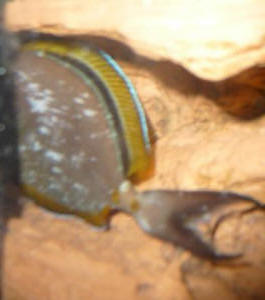 |
|
Re: worm, Naso QT, Protozoan fecal presence
2/1/09 Thanks for the compliments! Coincidentally, I
have a Naso tang in quarantine (for the past 4 weeks) that
stopped eating today. I noticed white hard fecal matter and
decided to look at that under a microscope. Well I saw (pics
attached) of something, possibly parasitic. Could you help
identify? <Mmm, other than appears Protistan/Protozoan, no...
but could be a commensal...> The Naso appears to be behaving
otherwise normally. The various pics are all pics of the same
thing. Thanks again! <I would not be overly concerned re
this... I would go ahead and place this Tang... as it is likely
to decline in the present small QT, and unlikely to infest the
DT. Bob Fenner>
|
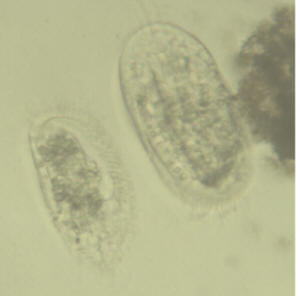 Ciliates at
400 X Ciliates at
400 X |
| Re: worm 2/1/09 I'm a bit hesitant to put
him in the DT b/c he did have Amyloodinium (verified
microscopically). <Mmm... okay> Treated with Chloroquine
diphosphate for 10 days. He's been doing well 4th day into
treatment and been doing well for the last 8 day post treatment (so
he's been doing well for 12 days) up until yesterday. Is it too
soon to put him into DT? thanks <Given this further data/input,
it is too soon. BobF> |
|
Naso Tang needs your help !! -- 01/22/09 WWM
Crew, <Kirk> I have had this Naso Tang for 2wks and notice
these splotches on his side. <Stress coloration...> My two
main questions are: 1. What is it?? 2. Is this something to be
concerned with? <Something too challenging... too small a
system, social incompatibility are the most common... And
yes> I have blue face angel and a Kole eye tang that are doing
well (added the same time as the Naso tang), only the Naso tang
is showing signs on this splotches. The Naso tang is picking
algae off the rock and sides of the tank. Eyes are clear and
seems alert. <Good signs> I am feeding Arcti-Pods,
Rod's Food (herbivore blend) and new life pellets. <Good
foods...> It also is eating Red Algae sheets that I put on an
algae clip (FWIW, all fish are eating from the algae clip).
<Good> I will give you the perfunctory water parameters:
ammonia, nitrites, nitrates all ZERO Mg is 1200 PO4 is ZERO Ca
425 pH 8.3 salinity 1.024 temp 77 Fish are housed in an
established (2yrs this May 2009) 375 gallon tank. <Mmm, good
sized system...> My main goal is to identify what the
splotches are and to determine if ANY action or treatment is
needed on my part. To see pics of the Tang, view my photos here:
<http://www.flickr.com/photos/7329275@N05/3217403650/>
http://www.flickr.com/photos/7329275@N05/3217403650/
<http://www.flickr.com/photos/7329275@N05/3216548959/>
http://www.flickr.com/photos/7329275@N05/3216548959/
<http://www.flickr.com/photos/7329275@N05/3216385885/>
http://www.flickr.com/photos/7329275@N05/3216385885/ thanks Kirk
<Mmm... well... it could be that this specimen was just
roughly handled (happens) on/during collection, processing from
the wild (many Naso lituratus are "picked up" on the
bottom at night while sleeping... have "hand prints" on
them...) or that it is simply adjusting to its new
surroundings... I would wait on doing anything overt here (not
move or "treat" it, the system)... and this Naso will
likely clear up in a few weeks. Bob Fenner>
|
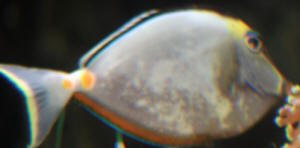 |
|
Re: Naso Tang needs your help
!! Bob, <Kirk> So whatever the stress coloration
the Naso has, is NOT contagious and will NOT be spread to other
fish in the tank, correct? <That is correct... with a very
high degree of confidence> This is my main concern. Thanks
Kirk <Welcome my friend. BobF>
Re: Naso Tang needs your help !!
1/27/2009 Bob, <Kirk> Today, I spoke to the online
vendor where I purchased the Naso tang. They viewed the photo and
said the splotches were caused by a bacterial infection and could
easily be treated with Maracyn II. <...> Do you agree with
this diagnosis ?? <No> Should I be worried about the health
of this tang? Thanks Kirk <Worried? No... worrying won't
change the future... Concerned? Sure... particularly if this
translates to further investigation, consideration and action (if
necessary) on your part. IF you'll take the time to read re
infectious marine fish disease (on WWM), you'll/you'd
find that such occasions are not generally "treatable"
per se... and the genus Naso in particular can't be easily
moved/sequestered in small volumes. Please... read, don't
write unless you have something novel to report or inquire re.
B>
|
|
Naso Tang 007, hlth. 10/14/08
Dear Crew, I First off, thank you for a wonderful web-site. I
just happen upon it a few weeks ago and thoroughly enjoying
reading all the vast amount of information. It's very
commendable of you to offer such a tremendous service. I do own a
copy of CMA. Great book Dr. Fenner! <Mmm, no doctorate, just
Bob, please> I'm somewhat of a newbie in that I left the
hobby several years ago as time constraints (i.e. 3 children)
along with moving to new residence kept me from re-establishing
my tank. Anyhow, my reason for writing today is that I am
starting up my 300 gal. FOWLR and have made my first fish
purchase. One of the fish being a 6" Blonde Naso Tang. This
fish was offered at discount through the retailer (F&S) you
mention on your web-site frequently. (I wonder if it had been in
their tank for long period of time, thus the reason for the
discounted price?) <Possibly> I received the fish on Weds.
afternoon and by Sat. morning he developed what appears to me to
be Lateral Line Disease. I am attaching a picture for your
review. <I see> The Naso was placed in quarantine tank 30
gal.(4' x 1' x 1' ) upon receipt on Weds. 10/08. The
water in the quarantine tank is being treated each day with
Kordon's Prevent Ich per their instructions. <Mmm,
won't "treat" HLLE... in fact the ingredients here,
the further stress... will drive all the other direction>
Water parameters are as follows: spg 1.023, <Mmm, low, but
likely better here for gas exchange purposes> ammonia 0,
nitrites 0, nitrates <5, temp. 76, ph 8.2. He is currently not
accepting food i.e. Mysis shrimp, krill dip in vita-Chem, red
algae w/garlic sheets, flakes, etc. <Stop! I would move this
fish (back) into the 300 gallon setting... The etiology/causative
mechanism of the syndrome shown won't "spread" as a
consequence to other livestock... and otherwise the chance of
this fish resolving is very small> He is not actively swimming
around tank, occasional stroll and then sits on bottom. <More
bad behavior> Today, Monday, he has started gilling. I have
been using a power head position right at the water-line to
agitate the surface so that there's plenty of air mixing with
the water. <Mmm, not for this species... Move it> Could you
please confirm my diagnoses and provide any other information on
treatment as well as suggestions on what else can be done to save
him. I read all that I could find own your web-site with respect
HIHLL and seems to me that the general consensus for its cause is
related to nutrition and water quality. <Yes, this is so>
With that being the case, what could have caused this condition
in such a short period of time (3 1/2 days) given the water
parameters? <Stress period... as you speculate, just how long
has this fish been kept, moved about in sub-par conditions?>
Your response most appreciated. <Welcome. Bob Fenner>
|
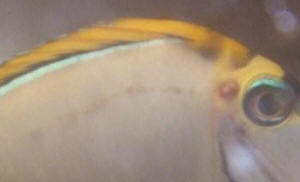 |
|
Re: Emailing: Naso Tag 007...
reading... Crypt 10/14/08 Thank you
Bob for your response. <Welcome Scott> Sorry about calling
you Dr. but, a man of with your wealth of knowledge and
experience certainly qualifies you to be one. Just wanted to
clarify a few things. First off, the Tang did perish yesterday
afternoon ( I wish I had received your reply sooner as I would
have acted on your advise to move him). Secondly, I was following
the personal recommendation of one Kordon's scientist/marine
biologist who said I should quarantine all tangs for about six
weeks <Mmm, please see at least WWM re my opinions here and
rationale for same... we differ> and treat the quarantine tank
initially with Kordon's organic Prevent Ich product <...
and my input re this product. NOT reliable> for seven days and
stop if no Ich presents. He stated that Tangs were notorious for
carrying Ich <This is so> and by using this product it
would likely eradicate any internal/external parasites( I assumed
he wasn't giving me a sales pitch!). <Mostly> The HIHLL
problem did not present until after nearly two days of
quarantining. <Likely the Kordon product was more cause
here...> I did not realize that the product in question would
create additional stress as there is no information to contrary
on Kordon's Prevent Ich label/ web-site. Thirdly, I did not
do a freshwater dip as your web-site seemed to indicate that this
method should not be utilized for Tangs unless parasites were
observed on the fish prior to placing it in the quarantine tank.
Would this have made a difference for this fish? <Perhaps...
but... only can guess> So should I be employing a different
strategy for my quarantining fish? <... you should... read>
This Kordon product is somewhat new and does not require water
changes during treatment (tremendous benefit). <... again,
take a look on the BBs... others input... Kordon is a good co.,
with many fine products... this is not one of them> All other
fish, yellow tang, blue hippo, and one spot fox face seem to be
doing fine during this treatment. Thank you again for your time.
Scott
<BobF>
|
|
Naso Problems!!!!! 9/19/08 I have
just received a Naso Tang in yesterday and noticed after I had
placed him in the QT this fungus "I am guessing" on the
side of the fish. <Mmm, no, not really> What do you think
it is and what would be the best course of action. Should I do a
freshwater dip with Methylene Blue, Formalin-3, or ParaGuard. Any
suggestion would be greatly appreciated. Brad <This is almost
assuredly "shipping/collecting damage"... As this
specimen looks to be in good shape otherwise, I'd leave it as
is to heal... can be quite quick to do so... a few weeks. Bob
Fenner>
|
 |
|
Naso Tang swimming strange
6/23/08 I have a Naso Tang (6 inches) that has been in the
tank about 3 months. In the tank with him are a Regal Blue Tang
(5 inches), Yellow Tang (3.5 inches), Yellow tail Coris (4
inches), Coral Beauty (3 inches) 2 3.5 inch Ocellaris clowns and
a lawnmower blenny. The Regal did have cloudy eye about 2 weeks
ago and I treated it with Focus and Metronidazole in the food.
<... what was the cause?> The cloudy eye are gone and he
has stopped scratching on the live rock in the last day or two.
The tank parameters are: 150 Gallon 200+lbs live rock 1.025
specific gravity 0 NO 2 5 NO 3 11 Alkalinity 8.2-8.4 Ph 0-.02 PO4
77-78.5 temp 400-450 Ca 1250 Magnesium <These all look
good> The Naso shows no outward signs of stress yet he will
swim normally and then jerk almost in a nervous twitch or as if
he had hic ups. <Natural behavior to extents> He does not
eat frozen food but eats dried seaweed and pellets with no
reservations. <Ah, good. No worries> After reading the FAQs
I am going to add a airstone for good O2 in the water. <Can do
little possible harm, but much good> I did just add a sulfur
denitrator about 4 weeks ago and that has brought the Nitrates
down from 25. They have been less than 10 the last 2 weeks and
this behavior started about 2 days ago. Water changes are about
30 gallons every 2 weeks. All top off is done with RO water.
<Mmm, I would not be overly concerned with the behaviors
stated. Perhaps some settling in with the S2 is occurring. Bob
Fenner>
Re: Naso Tang swimming strange 6/26/08 The cloudy
eye I believe was caused by my food. <?> I was thawing 1
weeks worth of San Francisco Bay brand frozen food (plankton,
Emerald Isle, Mysis Shrimp) and mixing it with vitamins and
garlic extract and leaving in the refrigerator. I found out you
should only do that for up to 48 hours. So, my suspect is that
the food had started to go bad and created the cloudy eye. I also
think that is why the Naso stopped eating the frozen and went to
eating the pellets and seaweed. <Mmmm> The Naso appears to
have stopped or reduced the jerky motions. It does have some
white discoloration on the edge of the upper part of one of his
gills. It does not appear to be getting larger or smaller. He is
eating fine so I suspect it is nothing to worry about. Thanks for
your reply. <Welcome... you have read the sections on WWM re
this genus, species? http://wetwebmedia.com/fishindex3.htm scroll
down. Bob Fenner>
|
Methylene Blue with Erythromycin? Naso lituratus
hlth., beh. 6/11/08 Hello Crew! <Charlie> I have
a somewhat urgent need for a definitive answer, I have searched
somewhat here and have not as of yet found my answer. I do know that it
is here, as I believe I have read it months ago. Yet, in my frantic
search cannot for the life of me locate it on this vast wealth of
information. So I come to you in hopes of finding it sooner. My thanks
in advance for the help you offer. Now my question. I have a 6 in or so
blond Naso tang. She has been housed in my 135 for approximately 15-16
months. <Will need more room than this> This fish is BTW my
favorite and I love Anna very much. This past weekend I relocated the
tank to another room. She was temporarily housed with 12 other fish in
a 65 filled with water straight from the 135. Anna was in there for
about 15 hours with a heater and a Koralia 4 for flow. All fish made it
back to the DT and were treated very well during the move. Most
including Anna were hand caught <Yikes...> as they feed from my
hand daily, and never saw a net. All look and act normally upon intro
back to the DT except Anna. She displayed the typical dark shading when
stressed and didn't feed the following day Sunday) Nor did she ever
really socialize. Last night, I found here laying still, slightly
curved and dark grey along the bottom. <Tangs do lay on the bottom
at night> She is very listless and just plain weak acting. Any
current will pin her in place. I have moved her into the 10 QT with an
air stone/heater and dosed erythromycin. <I would move this fish
back to the main display.> I cannot see any evidence of anything
wrong with this fish. She does have a sore on her side. But that was
definitely caused by being stuck against a power head. Which was caused
be her ailment. I don't have any idea what it may be. <My best,
high-confidence guess is psychological stress... from being moved, kept
in such a small volume... Will "get over it" in time...
likely under a week. But DO move this fish into the larger quarters,
now> However in a last ditch effort to save her, I administered the
erythromycin. <These are miscible... no problem> Finally
here's my question...LOL I want to know if dosing Methylene blue
along side the erythromycin is OK? <Yes> Also would it if it is,
be of any possible help/harm to her. Really I don't think she's
going to make it, but I will try anything you suggest. Also I feel as
though her problem is caused by some kind of trauma she may have
suffered while my watchful eyes were not upon her. I thank you and so
does Anna Charlie Bunch <Bob Fenner>
Naso Tang - Possible Ich? 04/05/2008 Hey guys,
how's it going. <<Hello, Andrew today>> I was just
going through your website and trying to figure out just what's
going on with my Naso Tang. I have had it for about a month and a half,
and am keeping it in a 55 gallon tank (I didn't do my research
prior to the purchase, but figured that I might keep it until there are
size issues). Anyways, the other day I came home, and my roommate
pointed out that there were white spots on the side of it. Immediately
I feared Ich, given the white spots and horror stories that I've
heard. But then under further research it seems unlikely that it could
be Ich. I have not introduced anything new to the tank in quite some
time, and it's behaviour seems to be quite normal. It's
breathing is regular, and feeding is normal as well. The white spots
are about 10 or so in number, and could be compared to the size of an
uncooked grain of rice. They are also definitely beneath the skin.
I've read that this is actually a characteristic of the tang,
however I do not feel fully convinced that I should pass on treatments.
So if there is any information you can offer me, or anything you can
tell me to be keeping an eye out for, it would be much appreciated.
<<Sounds like Ich to me, treat with hyposalinity. More can be
read here including the linked articles and FAQ's
http://www.wetwebmedia.com/ichart2mar.htm >> Thanks a lot,
Anthony. <<Thanks for the questions, hope this helps. A
Nixon>> <Mmm, much more likely embedded worms, possibly
Microsporideans... Not really treatable nor too debilitating. But...
this fish will likely perish in this too-small setting. RMF>
Re: Naso Tang - Possible Ich? 04/07/2008 They
don't seem like the regular sort of spots that Ich produces.
They're much bigger, and seem to come and go. Do you know anything
about the Naso Tang having such spots on it? Is this a characteristic
of the fish? And given that it has none of the other symptoms, and I
haven't introduced any new livestock to the tank in quite some
time, could Ich be eliminated as a possibility? Sorry if it seems like
I am refuting your far more knowledgeable opinion, but I'm just
looking to be convinced either way. Thanks again. <<It does sound
like Ich to me as these are very prone to this parasite. Their body
should be nice and smooth. Please do read more here. If you can provide
a close up photograph of the spot(s), then that would great.
http://www.wetwebmedia.com/naso.htm >> <<Thanks for the
follow-up. A Nixon>>
Surgeonfishes: Tangs for Marine Aquariums
Diversity, Selection & Care
New eBook on Amazon: Available here
New Print Book on Create Space: Available
here
by Robert (Bob) Fenner |
 |
|
|

